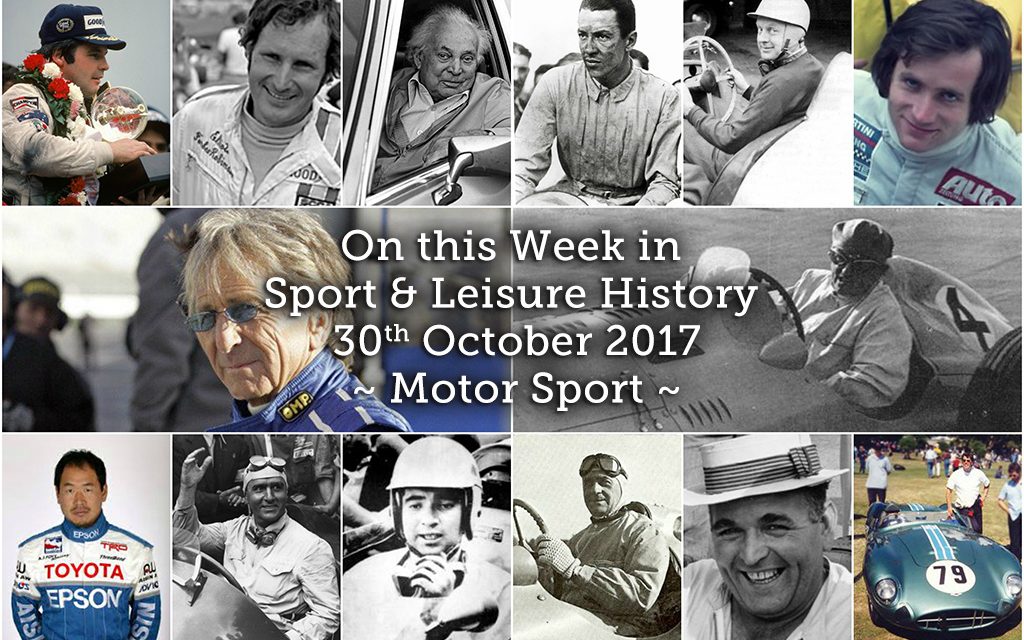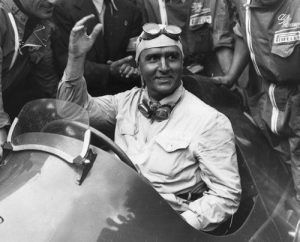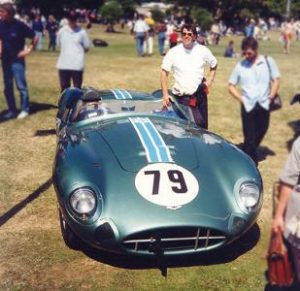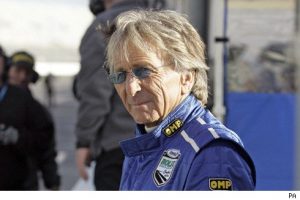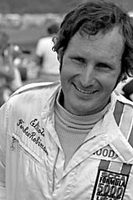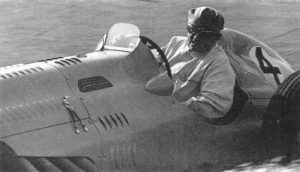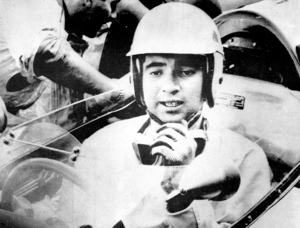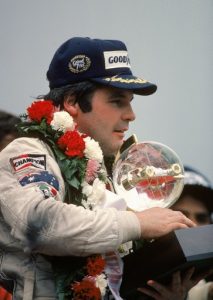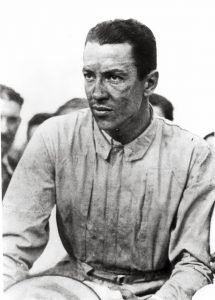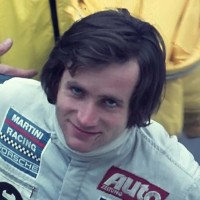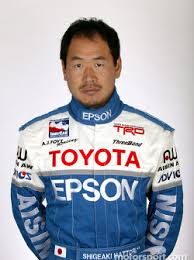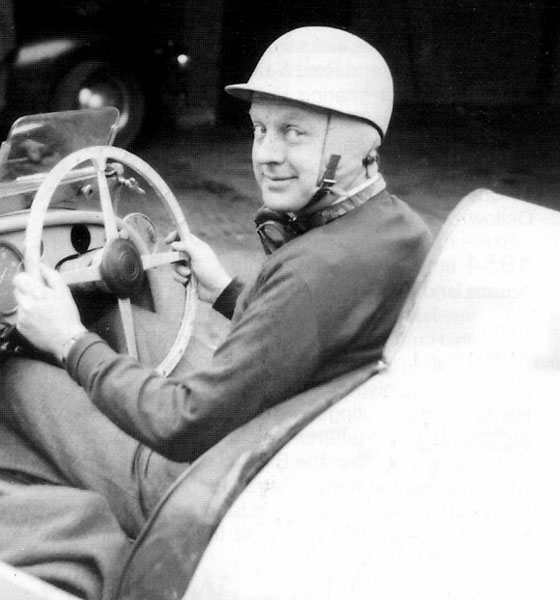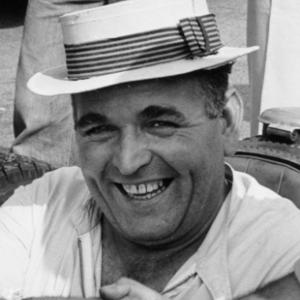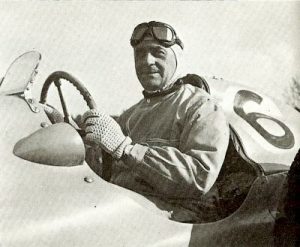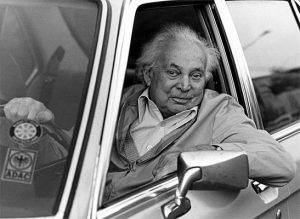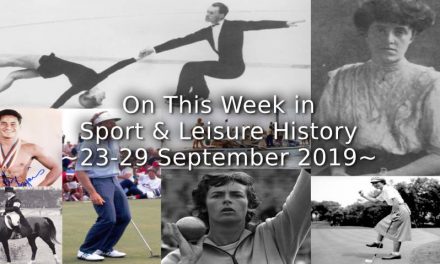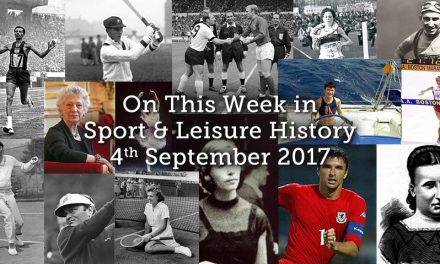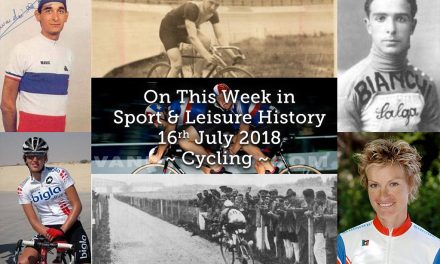30th– Nino Farina was born on this day in 1906. The first ever Formula One World Champion, he came from a privileged background and had a stylish driving technique that was later adopted by many drivers. A hard and determined racer, Farina relied on a combination of profound self-belief and raw courage to compensate for the superior skills possessed by many of his more naturally talented opponents. Yet he also drove recklessly and few Formula One drivers ever competed with such apparent disregard for their personal safety. Somehow surviving an accident-strewn racing career, he was eventually killed in a road accident. Giuseppe Antonio ‘Nino’ Farina was always destined to be involved in the automotive world, though not necessarily as a driver. On the day he was born his father, Giovanni, established Stabilimente Farina, a bodywork shop in Turin, the industrial city where much of Italy’s car manufacturing industry was located. Here also, Giovanni’s brother founded the coachbuilding firm of Pininfarina, later famed for designing many sleek Italian sportscars. From an early age Nino was expected to join the family business but his first driving experience, at the age of nine in a small car on the grounds of his father’s factory, whetted his appetite for the sporting side of motoring. When he was 16 Nino accompanied his favourite uncle Pinin as a passenger in a race. Three years later his first solo competition ended in an accident, establishing a worrying trend that continued throughout his crash-prone career. Farina was both athletically and academically inclined. In his youth he was a fast runner and became skilled at football and skiing. At the University of Turin he received a doctorate in law, while his academic title came easily his route to becoming World Champion was less straightforward. He began his military service as a cavalry officer, much enjoying the sensation of handling horses, then joined a tank regiment, in which he would serve during the war. Meanwhile, he continued to be obsessed by the lure of mechanical horsepower harnessed for competition purposes. In 1932 he bought an Alfa Romeo and quickly crashed it in a hill climb, breaking a shoulder and badly cutting his face. Undeterred, he raced Maseratis for a couple of years, crashing frequently but also showing enough promise to impress Enzo Ferrari, who recruited him to drive for the Scuderia Ferrari Alfa Romeo team. There, Farina befriended the legendary Tazio Nuvolari, whose talent and tenacity were both instructional and inspirational. Under Tazio’s tutelage he began to mature as a driver and in 1938 he won enough races to become Italian champion.After World War II Farina resumed racing and got married, to Elsa Giaretto, in her opinion motor racing was a silly and dangerous activity and she tried to persuade her new husband to stop. But three days after their high society wedding he flew to a race in Argentina. In 1950 he was appointed leader of the three-car Alfa Romeo team that competed in the series of Grand Prix races that were now formally organized by the FIA into the first ever Formula One World Championship. His mounting toll of injuries (including being seriously burned at Monza in 1954) meant Farina needed morphine and painkillers to continue tempting fate. Finally, pain overcame pride, and he retired from racing in 1955 and became a successful Alfa Romeo dealer. Farina’s interest in Formula One continued, as did his confidence in his driving ability. On June 30, 1966, he set out from Turin in a Lotus-Cortina, bound for the French Grand Prix at Reims. In the Alps near Chambery his car skidded off a slippery bend and the first World Champion was killed. French motor racing driver Maurice Trintignant was born today in1917. He competed in the Formula One World Championship for fourteen years, between 1950 and 1964, one of the longest careers in the early years of Formula One. During this time he also competed in sports car racing, including winning the 1954 24 Hours of Le Mans race. Following his retirement from the track Trintignant concentrated on the wine trade. Maurice Trintignant was the brother of Bugatti race car driver Louis Trintignant — who was killed in 1933, in practice, at Péronne, Picardy — and the uncle of renowned French film actor Jean-Louis Trintignant. He began racing in 1938, and won the 1939 Grand Prix des Frontières, but his career was interrupted by the Second World War, during which his own Bugatti was stored in a barn. When he rebuilt it for an event of 1945, the Coupé de la Liberation, he overlooked a clogged fuel filter, which caused him to drop out of the race. It transpired that the filter was plugged with rat droppings, earning him the unenviable nickname Le Petoulet, “the rat-droppings man”. During the course of his career, Trintignant drove a huge variety of cars, for many different teams: both works and privateer. Unusually, at the 1955 Argentine Grand Prix Trintignant shared both second and third places, a product of the Scuderia Ferrari policy of passing cars to their top drivers, should their original car break down. In 1956 he drove the Bugatti Type 251 in the French Grand Prix, becoming the last driver to represent the famed marque at a Grand Prix race. Even in his final season, driving his own BRM P57, he scored points, taking fifth place at the 1964 German Grand Prix on the intimidating Nürburgring. Following his retirement from racing, Maurice Trintignant returned to a quiet life as a wine-grower (naming his vintage Le Petoulet), near the town of Vergèze, in the Languedoc-Roussillon wine growing region, where he would eventually be elected mayor. Trintignant died, aged 87, in 2005. Belgium driver Jacques Swaters was born in 1926, a law student when he bought a pre-war MG with his best friend Charles de Tornaco. This was entered in the Spa 24 Hours for Swaters and another friend called Paul Frere. They finished fourth in class but Swaters had caught the racing bug and so he established a team called Ecurie Belgique and ran assorted pre-war machinery for an ever-widening group of friends, including Roger Laurent and Andre Pilette. In 1950 the team had enough cash to buy a Talbot-Lago Grand Prix car which they planned to enter in international events. At that point the Royal Automobile Club de Belgique decided that the name of the team was not acceptable and so it became Ecurie Francorchamps. While this was happening Swaters was also in the process of setting up a garage in Brussels which took on the name Garage Francorchamps. Pilette crashed the Talbot at the Dutch Grand Prix in 1951 and so Swaters took over the repaired car. They needed a new car and so Swaters purchased a Formula 2 Ferrari 500 from Gianni Agnelli, thus beginning a relationship with Ferrari which would continue for more than 50 years. In the years that followed the team ran the Ferrari and Swaters won the Formula 2 race at AVUS. That year Ferrari asked Swaters to be their representative at the Brussels Salon and then he became the Ferrari distributor for the Benelux area. The team also enjoyed success with a Jaguar C-Type in sports car events and finished fourth at Le Mans and third in the Reims 12 Hours with Laurent. Swaters then concentrated on sports cars, taking the team’s D-Type to third place at Le Mans with Johnny Claes in 1955. Swaters himself retired as a driver in 1957 to concentrate on his business which he sold a few years ago to the Inchcape Group. Tony Lee Bettenhausen Jr. a Champ Car team owner and driver who died in a 2000 plane crash, was born today in 1951. He was the son of former 14-time Indianapolis 500 competitor Tony Bettenhausen and the brother of 21-time Indy racer Gary Bettenhausen. The family holds the dubious distinction of the most combined starts in the famous race without a victory. Another brother, Merle Bettenhausen, was maimed in his only Indy Car start. In NASCAR history over the years on this day Tim Flock took the victory in both the 4th and 7th editions raced in 1952 and 1955 respectively. The 12th running of the race in 1960 was won by Rex White with David Pearson taking the checkered flag in the 16th race held on this day in 1966. Steve O’Rourke, one time manager of Pink Floyd after the departure of Syd Barrett in 1968 and who also built a highly successful parallel career as an enthusiastic gentleman racing driver, died today in 2003 aged 63. . A lifelong passion which he shared with the Floyd’s drummer Nick Mason and, to a lesser extent, David Gilmour, O’Rourke adored historic racing with cars of the 1950s, 1960s and 1970s. His ambition to compete at the Le Mans 24 Hours was realised in 1979 when he finished twelfth in his Ferrari 512 BB. He returned to Le Mans in 1980, but after a tyre exploded at nearly 200mph (320km/h) on the Mulsanne Straight, O’Rourke bought the spare tail of a retired sister Ferrari in the pit lane to finish. His car completed the race wearing green forward bodywork and a red tail.In 1981 he founded EMKA Racing and began competition in a BMW M1 with Derek Bell. For Le Mans he was joined by David Hobbs and Eddie Jordan. O’Rourke left the circuit on the night of the race to oversee a Pink Floyd concert in London, then flew back the next morning and jumped straight into the car for another two-hour driving stint. His team later became supported by Aston Martin and he assisted in the construction of a Group C sportscar for Le Mans in 1983. The car saw success by 1985, when it briefly led the 24-Hour in the hands of co-driver Tiff Needell and finished ahead of the works-backed Jaguars, to O’Rourke’s great amusement. However, the team briefly folded as Aston Martin left the project. O’Rourke greatest racing success came while co-driving a second-hand McLaren F1 GTR at Le Mans with Tim Sugden and Bill Auberlen to finish fourth overall. Having saved money by refusing the costly update pack for the McLaren, O’Rourke typically spent as much again on a huge party for all concerned in the EMKA team’s success. From 2000 O’Rourke concentrated on the FIA GT Championship driving an until he was forced to retire from driving for health reasons; he then presided over the drivers Tim Sugden, Martin Short, and factory Porsche driver Emmanuel Collard as they won at Pergusa and Anderstorp. Porsche responded by offering racing assistance to the EMKA factory for the 2004 season, to the delight of O’Rourke. O’Rourke’s death soon after the end of the 2003 season led to EMKA Racing folding.
- Nino Farina
- Steve O’Rourke
31st – Derek Bell, the most successful endurance racing driver in the history of British motor sport, was born on this day in 1941. Winning five times at Le Mans and being garlanded as the World Endurance Champion driver in 1985 and in 1986, the icing on the cake came when he was made a Member of the British Empire in 1987 for services to motor sport. Derek Bell is as well known in America as in Europe, with no fewer than 16 victories to his credit in the IMSA Camel GT Championship, all bar one shared with the legendary Al Holbert at the wheel of their Löwenbrau Porsche 962. Indeed, he aided Holbert to his IMSA driver championships in 1985 and 1986, a period which marks the high point in Bell’s illustrious career. He also won 16 World Championship races in the factory’s Rothmans-Porsches, making him the most successful driver of the 956 and 962 models with 32 victories from 144 starts. Bell’s racing career began in 1963 when, at the age of 22, he paid for a session at the Jim Russell Racing School at Snetterton, Norfolk. Unusually, Russell marked him out as a potential champion and with financial backing from his step-father, Bernard Hender, Bell worked his way through the ranks of Formula 3 and Formula 2, with considerable success that led to a “golden ticket”, a telegram from Enzo Ferrari to drive a factory car in the 1968 Monza Lotteria. Elation at putting the Ferrari on pole position turned to dismay as he was involved in a pile-up at the Parabolica, but still a contract was offered for 1969. This included two Formula One starts, at the Italian and US Grands Prix, though he finished neither on account of mechanical failures. Bell’s career then steered towards sports cars, first with Ferrari in 1970 followed by an invitation to join the Gulf Porsche team in 1971, as Jo Siffert’s co-driver. They won their first race, the Buenos Aires 1,000 Kms, but the Englishman reckons his best race was at Spa, where he put the Porsche on pole position at an average of 160 mph, and had to obey team orders to finish a close second to Pedro Rodriguez’s Porsche.He drove for the Gulf Mirage team for the next three seasons, his car not a match for the Ferrari and Matra factory teams. With Mike Hailwood, he won the Spa 1,000km in 1973 and with Jacky Ickx, his first Le Mans victory in 1975. Factory drives followed, for the Autodelta Alfa Romeo team, then the Renault factory’s Le Mans bids in 1977 and 1978, though not in the winning car. He was introduced to Al Holbert at Le Mans in 1980, when they shared a factory entered Porsche 924 Carrera GTR, and Bell was reunited with Porsche’s legendary race engineer Norbert Singer. This was the beginning of a superb eight-year relationship for Bell, with the Porsche factory and with Holbert’s IMSA team. Uniquely he won the Daytona and Le Mans 24-Hour races in 1986 and again in 1987, unbeaten in 96 hours, an achievement which will almost certainly never be repeated. Now retired, he was the consummate sports car driver, fast and supremely able to keep his cars out of trouble. He is proud to claim that in 25 starts at Le Mans, he has never put so much as a scratch on his cars, never lost a position due to driver error. Derek Bell has been associated with Bentley since 2000 as team consultant, and is now Brand Ambassador for Bentley Motors. American Elliott Forbes-Robinson was born in 1943, known for his race wins and championships in many different series, including the American Le Mans Series (ALMS), Super Vee, Trans-Am Series, CanAm, IMSA GTU, and the World Challenge. He is known in NASCAR circles as a road course ringer. He is also a founder of the Legends Cars of 600 Racing and he designed their original car. The racing industry is ever-changing. Teams, drivers and sponsors come and go before people remember they were there. But for over five decades now, at least one thing in motorsports hasn’t changed: Elliott Forbes-Robinson winning races. Getting his start in the Sports Car Club of America (SCCA), Forbes-Robinson went to driving school in 1968 in Riverside, Calif. Receiving his racing license shortly thereafter, he competed in his first professional race in a 289 Ford Cobra at Stardust Raceway in Las Vegas later that year. As soon as the checkered flag waved, he was hooked for life. Forbes-Robinson’s list of racing accolades is spread among a variety of racing entities. A former Trans-Am and sports car prototype champion, he has scored victories in over seven different series, winning at least one race in each of the past five decades. He won his first professional race in the Trans Am Series, winning in 1969 at Sears Point in a Allred brothers Porsche 911S. Not too long after, he agreed to run fellow road racing great Richie Ginther’s parts department in exchange for seat time in Ginther’s Porsche 914/6 and Super Vee cars. Quickly showing speed and potential, the driver now known simply as EFR, moved to the Formula Atlantic series, going wheel-to-wheel with some of racing’s brightest stars, most notably Gilles Villeneuve, Bobby Rahal and Danny Sullivan. He also became a staple of the second-generation Can-Am series in the late 70s and early 80s, joining Rahal and Sullivan but also battling on track with the likes of Jacky Ickx, Patrick Tambay and Al Holbert. Forbes-Robinson won the Trans-Am series championship in 1982. Every driver has a landmark victory that will forever be mentioned in the same breath. For EFR, that victory came in 1997, when piloting a Ford Riley & Scott with Andy Wallace, James Weaver, Butch Leitzinger, John Paul Jr. and Rob Dyson, Forbes-Robinson clinched his first overall victory in the Rolex 24 At Daytona. Two years later (again with Wallace and Leitzinger), EFR scored his second Rolex 24 victory. The win marked the beginning of a year which saw EFR win dual sports car championships, in USRRC and ALMS. Even with the list of accomplishments as long as it is, Forbes-Robinson remains one of the most approachable personalities in the paddock. His boyish demeanour and ear-to-ear smile endear him to fans and competitors alike. There isn’t a person who can better represent this enshrinement more than EFR, but don’t think for a moment that this induction signifies the end of an illustrious career. There’s a possibility that Forbes-Robinson will compete in the last two rounds of the Rolex Series-the nine-hour finale at the brand-new Miller Motorsports Park, and one week earlier at the site of his first pro win, some 37 years ago, at Sears Point. Australian Chris Alajajian was born today in 1986. In 2004 he won the Australian Production Car Championship, becoming the youngest ever driver to win an Australian championship. In the same year he also contested some rounds of the Australian Formula 3 Championship with Piccola Scuderia and raced in the Australian GT Performance Car Championship. Continuing in Australian Formula 3 in 2005, Alajajian started the year with Astuti Competition, before moving to Protecnica Racing. He finished third in the championship. Chris also won a number of races in the Australian Performance Car Championship with Protecnica Racing. A year later, in 1987, saw the birth of French driver Jean-Karl “J. K.” Vernay. In 2005 Vernay drove in the French Formula Campus series and finished first with six wins and 12 podiums from 14 races. The following year, he finished runner-up and best rookie in the French Formula Renault Championship with seven podium finishes. He drove two rounds as race driver in the 2006-07 A1 Grand Prix season and the last round as practice session driver. In 2007, Jean-Karl was selected to be part of the Red Bull Junior Team program that offers funding and support for promising young drivers. With Tom Dillmann, they were the first French drivers to take part in the programme. Vernay is still a part of the team, along with fellow Frenchman Jean-Éric Vergne. The same year, he raced in the Formula Three Euroseries with Signature-Plus team finishing 10th. Vernay has moved to the United States to race in the Firestone Indy Lights series in 2010 for Sam Schmidt Motorsports. He won in his series debut on the Streets of St. Petersburgin a wet race. He followed this up with another win at Barber Motorsports Park and a third-place finish at Long Beach, leaving him 28 points clear at the top of the standings after three rounds. Vernay went on to win four races that season and clinched the championship. Vernay is the first Indy Lights champion since 1996’s David Empringham to not go on to compete in IndyCar. In 2012, Vernay won the Porsche Carrera Cup France driving for Sébastien Loeb Racing. Vernay won the 24 Hours of Le Mans LMGTE Am class in 2013 while competing for IMSA Performance Matmut, driving a Porsche 997 GT3-RSR. He also contested in the full 2013 FIA World Endurance Championship season. In 2014, Vernay will drive for Weider Modulo Dome Racing in Super GT GT500 class. In 2016/17 to date, Vernay will drive a W Racing Team Volkswagen Golf at the TCR International Series. Sébastien Olivier Buemi was born in 1988, a Swiss professional racing driver, who formerly competed for Scuderia Toro Rosso in Formula One. Buemi is currently a reserve driver for Scuderia Toro Rosso’s sister team, Red Bull Racing, as well as being a member of Toyota’s FIA World Endurance Championship squad and Renault in the FIA Formula E Championship. Along with teammate Anthony Davidson, Buemi became World Champion in the LMP1 class of the FIA World Endurance Championship, in 2014. He won the second ever Formula E championship, the season held across 2015–2016, by two points for setting the fastest lap time in the final race despite not finishing the event. Canadian driver Gregory William Moore died today in 1999. He competed in the Indy Lights and CART World Series, where he had great success with several wins in both series and a championship in the 1995 Indy Lights series. He was fatally injured in a violent crash on the tenth lap of the 1999 CART season finale, the Marlboro 500, at the California Speedway in Fontana, California. Also on this day in 1999 the 50th Forumula One WDC was won by Mika Hakkinen by two points. Italian Roberto Lippi died aged 85 on this day in 2011. He participated in 3 Formula One World Championship Grands Prix, all of them in Italy, debuting on September 10, 1961. He started only one of these races, and scored no championship points. American racing driver, the first American to race cars successfully in Europe in the post-war era, John Cooper Fitch died today in 2012 aged 95. John Cooper Fitch was already a decorated World War II fighter and bomber pilot, and ex-POW, when he started racing after World War II. He was the Sports Car Club of America’s first national champion, in 1951. He raced MG, Allard, Sunbeam and Jaguar cars. He also raced specials of his own design, and he raced for the legendary American sportsman Briggs Cunningham and won the Argentine Grand Prix. Then, in 1952, he caught the attention of Mercedes-Benz racing boss Alfred Neubauer, who offered him a test drive in a factory race car. Fitch’s exploits as a Mercedes-Benz team driver with the likes of Stirling Moss, Karl Kling, and Juan Manuel Fangio are legendary. It was Fitch who convinced Neubauer that there was still time in the 1952 season to run the Carrera Panamericana, 2000 miles of racing over almost a week of race days. The Mercedes-Benz team went, in force, and they finished first, second and fourth overall, racing in the prototype sports cars that led to the development of the 300 SL Gullwing and roadster. Together, they won the sports car championship of the world in their first full season since the war. Fitch’s finest moment with Mercedes-Benz came in 1955 at the Mille Miglia, where Stirling Moss won overall, followed by Fangio, with Fitch coming in an astonishing fifth overall and first in the GT class with a basically stock 300 SL Gullwing, a feat of driving still regarded by many as one of the greatest performances of all time. When Mercedes-Benz left racing in 1955 after the tragedy at Le Mans, Fitch was picked by GM to manage the then-new Chevrolet Corvette racing team, and drive for the team, which he did, right on through the 1960 season. He continued to freelance with Cunningham Jaguars and Maseratis, and took time out to help design and later manage the Lime Rock Park racetrack in Connecticut. Fitch continued to race in Corvette, Jaguar, Maserati, Porsche, Lister, and Cooper race cars right through the 1966 Sebring race, after which he chose to retire from driving. Fitch spent the next 40 years since profitably, inventing road and race track safety systems, He also built and sold modified Corvairs, and built a Corvair-based car of his own design, the Fitch Phoenix, and patented safety equipment including soft walls and sliding barriers for race tracks.John Cooper Fitch stands out among that first great generation of American sports car racers, a gentleman, scholar, inventor, safety campaigner and raconteur extraordinaire.
- Derek Bell
- Elliott Forbes-Robinson
1st November -Belgium driver Arthur Legat was born in 1898, he took part in two Formula One World Championship Grands Prix, debuting on 22 June 1952. He scored no championship points. He won the Grand Prix des Frontières at Chimay in 1931 and 1932 in a Bugatti. Kenneth Henry Miles, British born, naturalised American sports car racing engineer and driver best known for his career in the USA and with American teams on the international scene was born today in 1918. Ken Miles survived World War II at the controls of a British Army tank only to perish behind the wheel of a prototype race car, but not before winning the 24 Hours of Daytona, the 12 Hours of Sebring and many other sports car races in a variety of machines. He also played a key role in turning Carroll Shelby’s Cobra into a race-worthy machine. Miles competed on motorcycles before the war, during which he served as a tank sergeant in the British Army. Miles switched to car racing after leaving the service. He ran Bugatti, Alfa Romeo and Alvis with the Vintage Sports Car Club, before taking on an old Ford V8-powered Frazer-Nash, which saw action at Silverstone, Brands Hatch and other venues. In early 1952, Miles moved to California. His first race in the States was in a stock MG TD at Pebble Beach. He was disqualified for reckless driving when his brakes faded without slowing his lap times. In 1953, he drove the tube-frame MG Special to 14 straight victories. He sold that car the next year to campaign a TF while building the famed Flying Shingle. Miles also ran a Triumph TR-3 in 1955 during the Shingle era. In 1956, he drove a Porsche Spyder. The next year he campaigned a Porsche-Cooper combination called the “Pooper,” which defeated the factory Porsche at Nassau. Miles was working with Porsche dealer John von Neumann, who according to one source was ordered to get the Pooper off the competition trail or lose his franchise. Miles ran an RSK Porsche for Otto Zipper, another dealer, in 1958. His next ride was a Maserati in 1961. That was the year he started test work for Rootes on the Alpine and helped develop the Dolphin Formula Junior. That work brought him to the attention of Carroll Shelby, who brought Miles onto the Cobra development team. He started as a driver and held several titles including competition manager. According to the Encyclopedia of Auto Racing Greats, Miles was responsible, perhaps more than Shelby, for turning the Cobra into a race-worthy machine. He also had a major part in the development of the Ford GT-40 and its Mk. II successor as well as that of the Mustang GT350. He later returned to Zipper part time in 1965 to drive a Carrera in the US Road Racing Championship. Miles died on Aug. 17, 1966 when the J-car he was testing at Riverside International Raceway in California suddenly looped, flipped and crashed. He was 47. Today in 1953, the 5th running of the NASCAR Sprint Cup was won by Herb Thomas and the following year, 1954, Lee Petty won the 6th NASCAR Sprint Cup. Welsh rally co-driver Nicky Grist was born today in 1961. His factory team career in the World Rally Championship lasted from 1993 to 2002. Grist’s first WRC win was in the Rally Argentina in 1993 with Juha Kankkunen, who at that time was a three times WRC champion. Grist and Kankkunen went on to win the 1993 WRC championship with Toyota. Grist stayed as Kankkunen’s co-driver until 1997 when he joined Colin McRae with the 555 Subaru World Rally Team. Grist remained Colin McRae’s co-driver until the Rally New Zealand 2002, during which time the pair two won 17 rallies, 27 podium finishes and gained overall 183 WRC points. Between 2002 and 2006, Grist and McRae also competed together in a number of one off rallies. Grist regularly sits in the co-driver’s seat for various drivers such as the Roger Albert Clark Rally and many more. In 2010 He attended the Rally Trinidad event in March with driver Mark Higgins 3-Time British Rally Champion, driving a Grp N Mitsubishi Evo IX. Ricardo Rodríguez, Mexcian racing drive, died in 1962 aged 20. He competed in the 1961 and 1962 Formula One seasons. His elder brother, Pedro, was also a noted racing driver who had much success in sports car racing and Formula One. He won several national motorcycle titles, before taking up saloon car racing in his own Fiat Topolino. In 1957 he made his international debut at Riverside, beating all comers in the under 1.5 litre class in a Porsche RS. He then won his class in a Porsche Spyder in the Nassau Tourist Trophy. He often raced for the North American Racing Team (NART) with his brother Pedro, although he would also enter cars under his father’s name. He was refused an entry at Le Mans in 1958 because was too young (16 years and 106 days), but went back in 1959 to race an OSCA in the 750cc. class. In the edition of 24 Hours of Le Mans in 1960 he partnered André Pilette to second place. At 18 years and 133 days of age, he was the youngest ever to stand on the podium at Le Mans. Rodríguez was given a guest drive by Ferrari for the 1961 Italian Grand Prix qualifying a surprise second and becoming the youngest driver in history to start from front row (19 years and 208 days), a record that wouldn’t be beaten until the 2016 Belgian Grand Prix by Max Verstappen. In the race he exchanged the lead with Phil Hill and Richie Ginther many times, until a fuel pump failure ended his race. 1962 saw a full works drive with Ferrari, who used him sparingly considering his age and rough edges. Whenever used, Rodríguez shone, taking second at the Pau Grand Prix, fourth at the Belgian Grand Prixand sixth at the German Grand Prix in a tough year in Formula One for Ferrari. He also won the Targa Florio 1962 edition with Olivier Gendebien and Willy Mairesse in a Ferrari Dino 246 SP. Rodríguez was considered a potential future champion already, but was left without a drive when Ferrari opted not to enter the non-Championship 1962 Mexican Grand Prix at the Magdalena Mixhuca Circuit, Mexico City. He signed to drive Rob Walker’s Lotus 24, but died during the first day of practice, when the Lotus’ rear right suspension failed at the fearsome Peraltada turn, and it hit the barriers killing him instantly. Today in 1982 Honda becomes the first Asian automobile company to produce cars in the United States with the opening of its factory in Marysville, Ohio; a Honda Accord is the first car produced there. The 49th Formula One WDC was won by Mika Hakkinen today in 1998 and on this day in 2009, the 60th Formula One WDC was won by 11 points by Jenson Button.
- Arthur Legat
- Ricardo Rodriguez
2nd -On this day in 1896 the first motor insurance policy was issued by the General Accident Company in England. The annual premium was 30 shillings (£1.50) and the terms excluded damage caused by frightened horses. Australian Formula One driver Alan Stanley Jones was born in 1946. He was the first driver to win a Formula One World Championship with the Williams team, becoming the 1980 World Drivers’ Champion and the second Australian to do so following triple World Champion Sir Jack Brabham. He competed in a total of 117 Grands Prix, winning 12 and achieving 24 podium finishes. In 1978 Jones won the Can-Am championship driving a Lola. Jones is also the last Australian driver to win the Australian Grand Prix, winning the 1980 event at Calder Park Raceway, having lapped the field consisting mostly of Formula 5000 cars while he was driving his Formula One Championship winning Williams FW07B. Stéphane Jean-Marc Sarrazin, French racing driver was born in 1975. He participated in just one F1 GP, the 1999 Brazilian Grand Prix, for Minardi. He was a replacement for Luca Badoer, who had injured his wrist. He suffered a big spin in the race coming up to the start/finish straight on lap 31 and scored no championship points. He also carried out testing duties for the Prost team during the 1999–2001 Formula One seasons and for Toyota Racing in their first season in 2002. Another French driver, Pierre Veyron, died today in 1970, aged 67. When Veyron enrolled at university to study engineering his friend, Albert Divo, convinced him to take up racing and introduced Veyron to André Vagniez, an industrialist who provided financial support to Veyron. Vagniez purchased a Bugatti Type 37A that Veyron drove to his first racing victory, the 1930 Geneva Grand Prix. Jean Bugatti, son of Bugatti founder Ettore Bugatti, hired Pierre Veyron in 1932 as a test driver and development engineer. Veyron entered races as a Bugatti company driver, winning many including the 1933 and 1934 Berlin Avus races while driving a Bugatti Type 51A. Veyron’s most significant race victory was his 1939 win at the 24 Hours of Le Mans, co-driving a Bugatti Type 57S Tank with Jean-Pierre Wimille. During World War II, Veyron joined the French Resistance against German occupation. For his service during the war, the Republic of France awarded him the Legion of Honour in 1945. After the war, Veyron continued racing, but his main focus was on his family and his oil-drilling technology company. Veyron died in Èze, France in 1970. Bugatti Automobiles S.A.S. named the Veyron 16.4 supercar in honour of Veyron. Today in 2008 the 59th Formula One WDC was won by Lewis Hamilton by a single point.
- Alan Jones
- Pierre Veyron
3rd-Austrian racing driver Helmuth Koinigg was born today in 1948 and died aged 25 in a crash in the 1974 United States Grand Prix, only his second Grand Prix start. Like several other Formula One drivers, Koinigg’s first racing car was a Mini Cooper. He purchased the car from Niki Lauda, which was also his first racing car. He raced in touring cars, Formula Vee and Formula Ford before a period in sports car racing. He subsequently found the finance to buy a seat with Scuderia Finotto driving their Brabham at his home grand prix in 1974, and although he failed to qualify, this led to a contract with Surtees for the last two races of the season.After a good showing at the 1974 Canadian Grand Prix, Koinigg was beginning to establish himself as a good prospect for 1975. But running near the back in the US Grand Prix at Watkins Glen, Koinigg’s car suffered a suspension failure at turn 7, pitching it head-on into the Armco barrier. The speed at which Koinigg crashed was relatively minor, and he ought to have escaped the scene uninjured. However, as with a number of other circuits at that time, the Armco was insecurely installed and the bottom portion of it buckled as the vehicle struck it. The car passed underneath the top portion, which remained intact, decapitating Koinigg and killing him instantly. Koinigg’s accident was reminiscent of the death of Formula One driver François Cevert in the same event the previous year. On this day in 1956, at the age of 87, John Davenport Siddeley, Lord Kenilworth, Chairman of the Armstrong-Siddeley Motors Ltd., died in Jersey. Born today in 1963 was Shigeaki Hattori, also called Shige Hattori, Japanese professional race car driver and team owner currently based in the United States. He competed in the CART and IndyCar Series, and the NASCAR Craftsman Truck Series (now the Camping World Truck Series). The 14th NASCAR Sprint Cup, raced on this day in 1963 was won by Joe Weatherly. On this day in 1966 the Maserati Ghibli, a two-door, two-seater coupe debuted at the Turin Motor Show. The V8-powered Ghibli was the most popular Maserati vehicle since the automaker withdrew from racing in the 1950s, and it outsold its two biggest rivals, the Ferrari Daytona and the Lamborghini Miura. The Ghibli’s steel body, renowned for its low, shark-shaped nose, was designed by Giorgetto Giugiaro. Giugiaro, who today works for ItalDesign, worked at coachbuilder Ghia when he designed the Ghibli. The car was powered by a front-placed quad-cam 370hp V8 engine. It had a 0-60 mph acceleration time of 6.8 seconds, had a top speed of 154 mph and could be operated by either a five-speed manual or three-speed automatic transmission. Maserati fitted the car with two fuel tanks, which could be filled via flaps on either side of the roof pillars. The car also featured pop-up headlamps, leather sport seats and alloy wheels. Today in 1968 the 19th Formula One WDC was won by Graham Hill with a 12-point margin. Born on this day in 1971, Italian driver Diego Alessi. He competed in the Italian Touring Car Championship from 1996–1999 and 2001–2002, then moved to the Trofeo Maserati Europe as well as making 3 starts in FIA GT for Autorlando Porsche. In 2008, Diego participated in the Rolex Sports Car Series, driving a Pontiac GTO.R with young Californian Ryan Phinny, for Matt Connolly Motorsports P1 Groupe. Sten Pentus, Estonian driver was born today in 1981 in Tallinn. A former Estonian Formula 4 Champion, and a previous winner of the Formula Baltic championship in a Reynard 903. At the end of the 2008 season, Pentus tested for GP2 Series teams DPR and Racing Engineering with respectable results considering his previous racing experience. In November, he tested with Fortec Motorsport in the Formula Renault 3.5 Series test in Valencia and again impressed, comparing favourably with F3 graduates Edoardo Mortara and Jaime Alguersuari during the two days. Fortec would later sign Pentus for the 2009 season on January 30, 2009. He scored his first points in the series when he finished second in the feature race at the Circuit de Catalunya, having started nineteenth. This earned Pentus a bonus point for the most places gained in the race. He achieved that again in the feature race at Spa, qualifying 19th and finishing 11th. He went on to finish sixteenth in the overall standings and finished sixth in the rookie championship overall standings. In 2014 Sten Pentus switched from single-seaters to GT racing, competing in the Blancpain Sprint series with the Bhaitech team in a McLaren MP4-12C GT3. Christian Bakkerud, Danish racing driver was born in 1984, he competed in the 2007 and 2008 GP2 Series seasons, albeit hindered by a recurrent back injury. Prior to GP2 he competed in British Formula 3 and Formula BMW. Bakkerud also made his Le Mans début in 2009, driving an Audi R10 TDI privately entered by Colin Kolles’s team. Paired with Christijan Albers and Giorgio Mondini, he finished ninth overall and in class. He returned to the event in 2010 with the same team and car, but on this occasion he, Albers and Oliver Jarvis failed to finish. Bakkerud retired from driving following the 2010 Le Mans race. In the year prior to his death, he worked as an import manager at a shipping company. On 10 September 2011, Bakkerud was involved in a car crash at the Tibbet’s Corner roundabout at Putney Heath, near Wimbledon Common. He died a day later, in St George’s Hospital, from his injuries. Today in 1985 the 36th Formula One WDC was won by Alain Prost and six years later on this same day in 1991 Ayrton Senna was crowned F1 WDC at the 42nd edition of the championship.
- Helmuth Koinigg
- Shigeaki Hattori
4th-On this day in 1919 Eric Thompson, British motor racing driver, book dealer and insurance broker was born. Eric ran a historic motorsports bookshop until quite recently, based near Guildford in Surrey. Until just before his death, Eric was still attending motorsport events. Formerly a Lloyd’s stockbroker, which severely curtailed his racing career and largely stopped Eric from progressing his career, as bar the Le Mans, he was very rarely able to race abroad. When he did get an opportunity to show what he could do, he excelled, finishing 5th in his only Grand Prix. A delightful, self-deprecating, witty fellow, a true gentleman, Eric retired from racing in 1956 to concentrate on his work at Lloyds, which he continued until 1979. He also worked as a time keeper for Aston Martin after his racing retirement and in 2013, was honoured by the Le Mans 24 Hours Hall of Fame. Thompson also fought in World War Two, serving as a Captain, and then a Major, in both North Africa and Italy and until 1946 was the commander in charge of the Central Mediterranean School of Signals in Padua. Bob Wollek, nicknamed “Brilliant Bob”, was a race car driver from Strasbourg, France was born today in 1943. He was killed on 16 March 2001 at age 57 in a road accident in Florida while riding a bicycle back to his accommodation after the day’s practice sessions for the following day’s race, the 12 Hours of Sebring. Prior to his racing days as a university student, Wollek was also a member of the French National Skiing Team between 1966-1968 competing in the Winter Universiade, he won three gold and two silver medals altogether. His skiing career came to an end when he was injured during preparations for the Winter Olympics. During his three decades of sports car racing, almost exclusively in Porsches, he won the 24 Hours of Daytona four times (1983, 1985, 1989, 1991) and the DRM in 1982 and 1983, with the Porsche 936 and Porsche 956 entered by the Joest Racing team. In the mid-1970s, he raced a Porsche 935 K2 improved and entered by the Kremer Racing team from Cologne. For many years, Monsieur Porsche challenged the factory team with privately entered cars, as he was only hired to become part of the official Porsche Le Mans team four times (1978, 1979, 1997, and 1998). In 1981, he even raced a Group C-spec Kremer-built Porsche 917, about a decade after these cars were retired initially. Wollek never managed to win the 24 Hours of Le Mans overall, despite coming close in a few of his thirty attempts. The last race Wollek entered was the 2001 12 Hours of Sebring in a Porsche 996 GT3-RS. Wollek had already won there in 1985 with A. J. Foyt, driving a Porsche 962. Despite being over 50 years of age and still racing competitively, Wollek had developed a fitness regime of riding bicycles to stay in good physical condition, especially for the longer races such as the 24 Hours of Le Mans, to which he rode from home across France. Typical of many other racing drivers, Bob ran a car dealership for Jaguar. Jacques-Joseph Villeneuve also known as Jacquo or Uncle Jacques was born in 1953, a Canadian racer, he is the younger brother of the late Gilles Villeneuve, and uncle to Jacques Villeneuve (1997 F1 world champion). He was born in the small town of Berthierville, Quebec. He is now frequently known as Uncle Jacques because of the rise of his nephew. He had a varied motorsport career, taking in Formula Atlantic, CART, Can-Am, snowmobile racing and Formula One, and remains a revered figure in Canadian motorsport circles. Villeneuve was the first three-time winner of the World Championship Snowmobile Derby. Bruno Junqueira, Brazilian race car driver was born in 1976. He is a former Formula 3000 champion and three-time runner-up in the Champ Car World Series. Horace Gould (born Horace Harry Twigg died in 1968 aged 47. A British racing driver from Bristol, known for his portly frame and larger-than-life character, Gould began racing sports cars in 1952 at the wheel of a Cooper-MG. He moved into Formula One in 1954, competing as a privateer and using the team name Gould’s Garage (Bristol). He participated in 17 Formula One World Championship Grands Prix, debuting on 17 July 1954, plus numerous non-Championship races. He scored a total of 2 championship points, thanks to driving his Maserati 250F to fifth place in the 1956 British Grand Prix, enough to earn him joint 19th place in that season’s World Championship. He won minor non-championship Formula One races at Castle Combe in 1954 and Aintree in 1956, and also won two points in the 1957 World Sportscar Championship, finishing in 5th place in that season’s 1000km of Nürburgring, sharing a Maserati 300S with teammates Stirling Moss, Juan Manuel Fangio and Chico Godia. Although most of Gould’s career was spent in England, he also had spells living and racing in New Zealand and Modena, Italy, home of the Maserati factory. The similarity of Gould’s build and driving style to those of José Froilán González led to him being dubbed “the Gonzalez of the West Country”. Gould died suddenly, in Southmead, England, of a heart attack. His sons Martin, Stephen and Richard still live in Bristol.Martin went into motor racing and raced in Formula 3, and two of his grandchildren Daniel Gould and James Gould also had careers at a young age in motorsport. On this day in 1976 at the age of 70, German motorcycle and racing driver Anton “Toni” Ulmen passed away. His racing career started in 1925 on a 250 cc Velocette. In 1927 he won the opening race of the Nürburgring on a 350 cc Velocette. In 1929 he won the 350 cc class on the Eilenriede, a non-permanent race course near Hanover. From 1949 to 1952, he was four times German sports car and Formula 2 champion. After leaving school, Ulmen served an apprenticeship as a machinist with Motorradwerkstatt Hasenclever. When he finished there, he founded Gebrüder Ulmen, with his brother Andreas.They become the representatives of Opel for Düsseldorf. It was in 1925 that Ulmen began his career in motorsport, at the Großen Deutschland-Rundfahrt on a 250cc Velocette motor cycle. Two years later can riding a 350 cc Velocette he won the first Eifelrennen, to claim the Deutsche Tourist-Trophäe, the inaugural race held on the Nürburgring.In 1929, he won another major German race, the 350cc race of Eilenridederennens in Hanover. By 1930, Ulmen was a works rider for NSU. After the war, he turned to car racing, taking a second place in his first major sportscar race, the Karlsruhe-Durlach, abroad a BMW 328.A year later, in 1947 he was awarded the title of best German sports car driver of the year. Following his racing retirement, Ulmen become president of the Deutscher Motorsport Verband (DMW) and he received the Silbernes Lorbeerblatt award from President of Germany, Theodor Heuss for his successes in motorsport, the highest national award in Germany for an athlete. The 41st Formula 1 WDC was won in 1990 by Ayrton Senna by seven points.
- Eric Thompson
- Harold Gould
5th-Born on this day in 1905, French driver, Louis Rosier. He participated in 38 Formula One World Championship Grands Prix, debuting on 13 May 1950. He achieved two podiums, and scored a total of 18 championship points. He won the Dutch Grand Prix twice in consecutive years between 1950 and 1951, the Circuit d’Albi, Grand-Prix de l’Albigeois and the 24 Hours of Le Mans with his son Jean-Louis Rosier. Rosier owned the Renault dealership of Clermont-Ferrand, he sustained head injuries in a crash at the Montlhéry track, south of Paris, on 7 October 1956. Three weeks later, on 29 October 1956, Rosier succumbed to the injuries received in the crash. Today in 1926 the Buick 1927 ‘Goddess’ mascot was patented by designer William Schnell. Today in 1950 the first Pebble Beach Road Races (California) were staged, with the main event won by Phil Hill in a Jaguar XK120. The races were managed under the auspices of the SCCA (Sports Car Club of America), as were most races from that day to this. The route was originally 1.8 miles (2.9 km) long, but was lengthened from 1951 onwards to 2.1 miles (3.4 km). Not all of the “track” was paved; the original 1950 route consisted of both paved two-lane roads and sections of dirt or loose gravel. On this day in 1952, Joe James, who competed in two Indianapolis 500s, died after an accident three days earlier at San Jose Speedway. A native of Mississippi, that year he was the AAA Midwest Sprint car Champion with six victories to his name. On October 17th he was crowned as the champion at a banquet in Dayton, Ohio. Sixteen days later he was blinded by the sun, failed to see a yellow flag and ran over a wheel on the track. His car flipped and he suffered massive head injuries. A Joe James Memorial Auto Race, set up in 1953, ran every year until the track was closed in 1999. In 1966 David Piper and Richard Atwood drove a Ferrari 365P2/3 to victory in the 9-hour sports car race at Kyalami, South Africa. On this day 1978 Richard Petty appeared to win the NASCAR Winston Cup race at Atlanta, Georgia, USA, but after the scoring was rechecked, the win was given to Donnie Allison. This was Allison’s last career victory. Today in 1980 Jaime Camara was born in Goiânia, Brazil, who most recently competed in the IndyCar Series for Conquest Racing. Camara previously took part in the 2005 and 2006 seasons of the Indy Racing League’s Indy Pro Series and finished 5th and 6th in series points, respectively. He has also won the 2005 Freedom 100, the Indy Pro Series’ biggest race, from the pole. He sought a ride in the Indy Racing League IndyCar Series during the 2006-2007 offseason, but could not put a deal together and returned to the IPS and Andretti Green Racing for the 2007 season. He finished 6th in points for the second year in a row without scoring a win. On April 24, 2008 he was announced as the driver of the #34 Conquest Racing entry in the IndyCar Series beginning with the Road-Runner Turbo Indy 300 at Kansas Speedway and will remain through the balance of the season. At the Indianapolis 500 he pulled into the wrong pit box, delaying teammate Enrique Bernoldi in the process; he later crashed out in a single-car incident. After a very strong run at Richmond International Raceway, where he moved from a starting position of 24th up to first where he led 44 laps, he crashed out in another single-car incident. He finished the season 23rd in points. He participated in a test with the Conquest team prior to the 2009 season, but Alex Tagliani was named the driver for the team’s single car prior to the beginning of the season. Briton Nick Tandy was born in 1984 who is currently racing for Porsche Motorsport as a factory driver in the FIA World Endurance Championship LMP1 class. He won the 2015 24 Hours of Le Mans with co-drivers Earl Bamber and Nico Hülkenberg. Adolf Brudes von Breslau died on this day in 1986 aged 87, a Formula One driver from Germany he was a member of German nobility. He started racing motorcycles in 1919. As an owner of a BMW and Auto Union dealership in Breslau, he had the opportunities to go racing, which he did from 1928 onwards, initially in hill climbs. After World War II wiped out his business, he moved to Berlin and for a while became a mechanic, wherever he could find jobs. However, he soon was back racing, and he continued until 1968 – an amazing career of 49 years. He participated in one World Championship Grand Prix, the 1952 Großer Preis von Deutschland, but scored no championship points. He also participated in several non-Championship Formula One races. In 1987, Sports car and Grand Prix driver, Adolf Brudes von Breslau died at the aged of 50. Brudes began his racing career on motorcycles before switching to cars, taking third place in the 1940 Coppa Brescia just before Italy’s entry into the Second World War. He started racing again after the war and took part in the 1952 German Grand Prix in a Veritas RS-BMW after which he competed in many varied production car events, mainly for Borgward. On a rainy day in Adelaide the 1989 Australian Grand Prix was stopped after only one lap due to excessive rain. On the restart, Ayrton Senna led the field from pole, but retired after 13 laps. His friend Thierry Boutsen gained the lead after starting 3rd on the grid and scored his second Grand Prix win. Boutsen had earned his first win in Canada earlier that season. Senna went on to claim the WDC that day. George Barris (born George Salapatas; died today in 2015, an American designer and builder of many famous Hollywood custom cars, most notably the Munster Koach and 1966 Batmobile.
- Louis Rosier
- Adolf Brudes von Breslau

